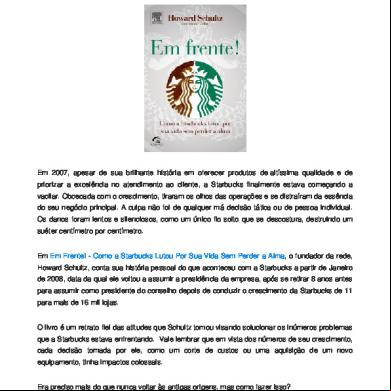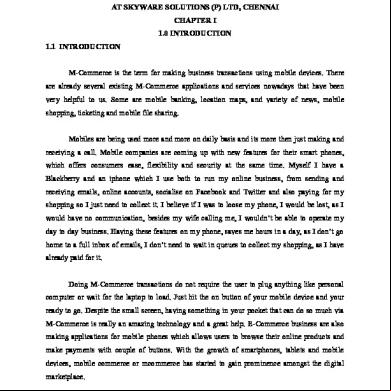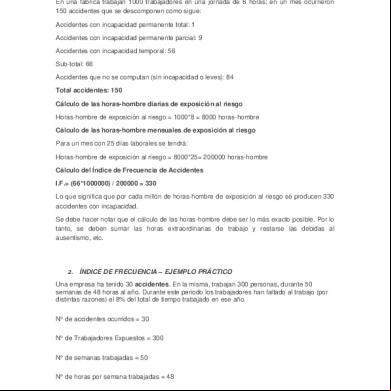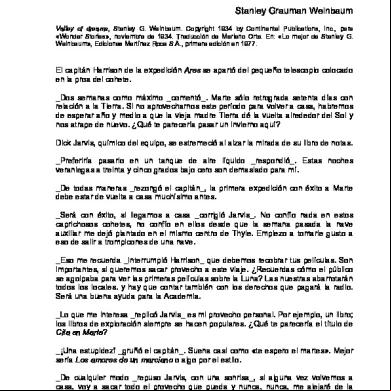Hiperpolarização Em Ressonância Magnética22 5b2r4t
This document was ed by and they confirmed that they have the permission to share it. If you are author or own the copyright of this book, please report to us by using this report form. Report 2z6p3t
Overview 5o1f4z
& View Hiperpolarização Em Ressonância Magnética22 as PDF for free.
More details 6z3438
- Words: 1,234
- Pages: 30
HIPERPOLARIZAÇÃO EM RESSONÂNCIA MAGNÉTICA
Projeto final em Radiologia Autor: Tiago M.C. Sequeiros Nº 10080419
Vila Nova de Gaia – Setembro 2012
OBJETIVOS • Demonstrar o impacto das doenças pulmonares na qualidade de vida; • Conhecer os principais meios de diagnostico de patologia pulmonar;
• Entender algumas técnicas e limitações da RM Pulmonar convencional; • Ficar com a perceção das propriedades dos gases utilizados em hiperpolarização em RM pulmonar, assim como as técnicas atualmente disponíveis; • Perceber as principais patologias em que o uso de gases hiperpolarizados é vantajoso.
INTRODUÇÃO • A patologia pulmonar possui grande efeito na qualidade de vida de um indivíduo. • Causas - Fatores exógenos - Tabagismo-23%* • Aperfeiçoamento das técnicas de diagnóstico
• Necessidade de combinar a parte morfológica e funcional • --»Técnica de gases hiperpolarizados em RM • Desenvolvida devido à escassez de sinal nos exames de RM pulmonar.
* Fonte: Estudo colocado no jornal Expresso, dia 31 de Maio de 2012
MÉTODOS DE DIAGNÓSTICO
Morfológico
Funcional
• Raio –x • Tomografia computorizada • Ressonância magnética convencional • Histologia
• Espirometria • Pletismografia • Prova de capacidade de difusão do monóxido de carbono • Cintilografia Pulmonar
Ressonância magnética
Com utilização de gases hiperpolarizados
TESTES DE FUNÇÃO PULMONAR Vantagens:
• Informação funcional: ventilação e trocas gasosas • Disponíveis em meio clínico • Baixo custo do equipamento Desvantagens: • Sem informação regional • Insensível a doenças em estados iniciais e progressão gradual • Problemas no decorrer do exame – incapacidade/ não colaboração do utente
Espirometria
RESSONÂNCIA MAGNÉTICA PULMONAR • 1978 -» Um dos primeiros exame de RM, ao tórax
Fonte: Exposição no Museu da Ciência em Londres (19/08/2012)
RESSONÂNCIA MAGNÉTICA PULMONAR •
Qualidade da imagem: depende muito da colaboração do doente.
•
Mais-valia: não usar radiação ionizante
•
Propriedades físicas: devido à baixa densidade protónica
Fonte: Biederer J. et all, (2/3), 2012
HIPERPOLARIZAÇÃO
Potencialidade desta técnica: - Avaliar a densidade de spins - Avaliar as trocas gasosas efetuadas em cada região do pulmão Fonte: http://bjr.birjournals.org/content/76/suppl_2/S118/F1.expansion.html
GASES UTILIZADOS •
3He
Isótopo raro Gás inerte, abundante na lua Insolúvel no sangue Rácio giromagnético de 32,3MHz/T Difusibilidade no ar 0,9cm 2/s
•
129Xe
Surge como uma mistura de isótopos com abundância natural de 26% Difunde-se facilmente para o sangue Rácio giromagnético de 11,78MHz/T Difusibilidade no ar 0,1cm2/s
MÉTODOS DE POLARIZAÇÃO • Spin Exchange Optical pumping – SEOP 3He
Fonte: Nacher P. (2008)
MÉTODOS DE POLARIZAÇÃO • Meta-Stable Spin Exchange Optical Punping MEOP
Fonte: Nacher P. (2008)
MÉTODOS DE POLARIZAÇÃO • Spin Exchange Optical pumping – SEOP 129Xe
Fonte: Baert A. (2009); Nacher P. (2008)
UTILIZAÇÃO HISTÓRICA DE GASES HP EM RM • 1994 -» Primeiros estudos de imagens de ventilação com 129Xe em pulmões retirados de um rato . Albert et al.(1994) Fonte: Albert et all.(1994)
• 1995- 1996 -»Estudos in vivo em humanos com 3He Fonte: Schmiedeskamp J., (2004)
REQUISITOS PARA A REALIZAÇÃO DE UM EXAME COM GASES HP EM RM: • Equipamento de RM, sintonizado para a frequência de precessão do gás HP • Antena com um tamanho adequado para envolvimento a 360º do utente na zona em estudo, angulo de excitação uniforme, baixo tempo de inoperação entre exames. • Equipa multidisciplinar com alguma experiência • Gás hiperpolarizado, devidamente acondicionado • Sequências de pulso adaptadas
PARÂMETROS USADOS EM ESTUDOS Autor
Sequência
TR
TE
FA
Espessura de corte/espaçamento
matriz
Outros
Mc Adams GRE et all (1999)
9.5ms
3ms
8º
6/2mm
128x256
FOV 32cm
Gierada et all (2000)
EPI
40.5ms 12.1 ms
22º
10/--mm
32x64
ETL=32
Salerno et all (2002)
FLASH
9ms
3.7m s
10/15º
10/--mm
100x256
FOV 45x50 cm
Cleveland SPGRE et all (2010)
7.9ms
1.9m s
5-7º
15/--mm
FOV 40x40cm
CICLO DO 3HE
Fonte: http://www.ag-heil.physik.uni-mainz.de/Dateien/He-cycle.jpg
TÉCNICA MAIS PROMISSORA– XENON TRANSFER CONTRAST - XTC • Permite a análise das trocas gasosas
• Fase gasosa -» Fase intermédia -» Fase dissolvida • Análise do sinal obtido em cada fase
Fonte: Mugler, (2012)
PATOLOGIAS AVALIADAS COM GASES HP • Avaliação pós transplante pulmonar
Fonte: Morrel G., 2002
PATOLOGIAS AVALIADAS COM GASES HP • Enfisema
Fonte: Mugler, (2012)
PATOLOGIAS AVALIADAS COM GASES HP • Enfisema
Fonte: Swift et all, (2005)
PATOLOGIAS AVALIADAS COM GASES HP • Fibrose cística
Fonte: Salerno M. et all, (2001)
PATOLOGIAS AVALIADAS COM GASES HP • Asma Fonte: http://www.drpereira.com.br/asma.htm, 14/09/2012
Fonte: Salerno M. et all, (2001)
PATOLOGIAS AVALIADAS COM GASES HP • Doença pulmonar obstrutiva crónica
Fonte: Gierada et all, (2000)
INDIVIDUO SAUDÁVEL VS DPOC
Fonte: Wild JM. Et all, (2003)
INOVAÇÕES • 2011 – Polarean investe na comercialização de máquinas polarizadoras
Fonte: www.polarean.com
SÍNTESE • Patologia pulmonar- grave problema a nível mundial • Uso dá técnica de gases hiperpolarizados em RM oferece informação funcional e estrutural em casos de indivíduos saudáveis, em estados iniciais de patologia, ou com patologia já instaurada • Através da disseminação livre desta técnica de gases hiperpolarizados, estudos inovadores irão surgir, assim como novos métodos associados a esta técnica com novos resultados
OBRIGADO PELA ATENÇÃO
Agradecimentos: Drº Eduardo Ribeiro Drº Davide Freitas Drº Ernesto Pinto
Fonte: Imagens fornecidas por Drª Helen Marshall and Prof Jim Wild, University of Sheffield
BIBLIOGRAFIA •
Biederer J, Beer M, Hirsch W, Wild J, Fabel M, Puderbach M, et al. MRI of the lung (2/3). Why … when … how? Insights Imaging. 2012 Feb. PubMed PMID: 22695944. ENG.
•
Nacher P. MRI : From Spin Physics to Medical Diagnosis. Quantum Spaces. 2008:1-35.
•
Baert A, Knauth M, Sartor K. MRI of the lung. Kauczor H-U, editor. : Springuer; 2009. 314 p.
•
Albert MS, Cates GD, Driehuys B, Happer W, Saam B, Springer CS, et al. Biological magnetic resonance imaging using laser-polarized 129Xe. Nature. 1994 Jul;370(6486):199-201. PubMed PMID: 8028666. eng.
•
5
•
McAdams HP, Palmer SM, Donnelly LF, Charles HC, Tapson VF, MacFall JR. Hyperpolarized 3He-enhanced MR imaging of lung transplant recipients: preliminary results. AJR Am J Roentgenol. 1999 Oct;173(4):955-9. PubMed PMID: 10511156. eng
•
Gierada DS, Saam B, Yablonskiy D, Cooper JD, Lefrak SS, Conradi MS. Dynamic echo planar MR imaging of lung ventilation with hyperpolarized (3)He in normal subjects and patients with severe emphysema. NMR Biomed. 2000 Jun;13(4):176-81. PubMed PMID: 10867693. eng.
•
Salerno M, de Lange EE, Altes TA, Truwit JD, Brookeman JR, Mugler JP. Emphysema: hyperpolarized helium 3 diffusion MR imaging of the lungs compared with spirometric indexes--initial experience. Radiology. 2002 Jan;222(1):252-60. PubMed PMID: 11756734. eng.
•
Cleveland ZI, Cofer GP, Metz G, Beaver D, Nouls J, Kaushik SS, et al. Hyperpolarized Xe MR imaging of alveolar gas uptake in humans. PLoS One. 2010;5(8):e12192. PubMed PMID: 20808950. Pubmed Central PMCID: PMC2922382. eng.
•
Mugler J. Hyperpolarized-Gas MRI of the lung: Can research Potencial Translate to Clinical Application? Presented at SPIE Medical Imaging 2012
•
Morrell G. Potential clinical applications of magnetic ressonance imaging of hyperpolarized helium and xenon. Supplement to applied radiology. 2002;December:4550.
•
Swift AJ, Wild JM, Fichele S, Woodhouse N, Fleming S, Waterhouse J, et al. Emphysematous changes and normal variation in smokers and COPD patients using diffusion 3He MRI. Eur J Radiol. 2005 Jun;54(3):352-8. PubMed PMID: 15899335. eng.
•
Salerno M, Altes TA, Mugler JP, Nakatsu M, Hatabu H, de Lange EE. Hyperpolarized noble gas MR imaging of the lung: potential clinical applications. Eur J Radiol. 2001 Oct;40(1):33-44. PubMed PMID: 11673006. eng.
•
Wild JM, Paley MN, Kasuboski L, Swift A, Fichele S, Woodhouse N, et al. Dynamic radial projection MRI of inhaled hyperpolarized 3He gas. Magn Reson Med. 2003 Jun;49(6):9917. PubMed PMID: 12768575. eng.
Projeto final em Radiologia Autor: Tiago M.C. Sequeiros Nº 10080419
Vila Nova de Gaia – Setembro 2012
OBJETIVOS • Demonstrar o impacto das doenças pulmonares na qualidade de vida; • Conhecer os principais meios de diagnostico de patologia pulmonar;
• Entender algumas técnicas e limitações da RM Pulmonar convencional; • Ficar com a perceção das propriedades dos gases utilizados em hiperpolarização em RM pulmonar, assim como as técnicas atualmente disponíveis; • Perceber as principais patologias em que o uso de gases hiperpolarizados é vantajoso.
INTRODUÇÃO • A patologia pulmonar possui grande efeito na qualidade de vida de um indivíduo. • Causas - Fatores exógenos - Tabagismo-23%* • Aperfeiçoamento das técnicas de diagnóstico
• Necessidade de combinar a parte morfológica e funcional • --»Técnica de gases hiperpolarizados em RM • Desenvolvida devido à escassez de sinal nos exames de RM pulmonar.
* Fonte: Estudo colocado no jornal Expresso, dia 31 de Maio de 2012
MÉTODOS DE DIAGNÓSTICO
Morfológico
Funcional
• Raio –x • Tomografia computorizada • Ressonância magnética convencional • Histologia
• Espirometria • Pletismografia • Prova de capacidade de difusão do monóxido de carbono • Cintilografia Pulmonar
Ressonância magnética
Com utilização de gases hiperpolarizados
TESTES DE FUNÇÃO PULMONAR Vantagens:
• Informação funcional: ventilação e trocas gasosas • Disponíveis em meio clínico • Baixo custo do equipamento Desvantagens: • Sem informação regional • Insensível a doenças em estados iniciais e progressão gradual • Problemas no decorrer do exame – incapacidade/ não colaboração do utente
Espirometria
RESSONÂNCIA MAGNÉTICA PULMONAR • 1978 -» Um dos primeiros exame de RM, ao tórax
Fonte: Exposição no Museu da Ciência em Londres (19/08/2012)
RESSONÂNCIA MAGNÉTICA PULMONAR •
Qualidade da imagem: depende muito da colaboração do doente.
•
Mais-valia: não usar radiação ionizante
•
Propriedades físicas: devido à baixa densidade protónica
Fonte: Biederer J. et all, (2/3), 2012
HIPERPOLARIZAÇÃO
Potencialidade desta técnica: - Avaliar a densidade de spins - Avaliar as trocas gasosas efetuadas em cada região do pulmão Fonte: http://bjr.birjournals.org/content/76/suppl_2/S118/F1.expansion.html
GASES UTILIZADOS •
3He
Isótopo raro Gás inerte, abundante na lua Insolúvel no sangue Rácio giromagnético de 32,3MHz/T Difusibilidade no ar 0,9cm 2/s
•
129Xe
Surge como uma mistura de isótopos com abundância natural de 26% Difunde-se facilmente para o sangue Rácio giromagnético de 11,78MHz/T Difusibilidade no ar 0,1cm2/s
MÉTODOS DE POLARIZAÇÃO • Spin Exchange Optical pumping – SEOP 3He
Fonte: Nacher P. (2008)
MÉTODOS DE POLARIZAÇÃO • Meta-Stable Spin Exchange Optical Punping MEOP
Fonte: Nacher P. (2008)
MÉTODOS DE POLARIZAÇÃO • Spin Exchange Optical pumping – SEOP 129Xe
Fonte: Baert A. (2009); Nacher P. (2008)
UTILIZAÇÃO HISTÓRICA DE GASES HP EM RM • 1994 -» Primeiros estudos de imagens de ventilação com 129Xe em pulmões retirados de um rato . Albert et al.(1994) Fonte: Albert et all.(1994)
• 1995- 1996 -»Estudos in vivo em humanos com 3He Fonte: Schmiedeskamp J., (2004)
REQUISITOS PARA A REALIZAÇÃO DE UM EXAME COM GASES HP EM RM: • Equipamento de RM, sintonizado para a frequência de precessão do gás HP • Antena com um tamanho adequado para envolvimento a 360º do utente na zona em estudo, angulo de excitação uniforme, baixo tempo de inoperação entre exames. • Equipa multidisciplinar com alguma experiência • Gás hiperpolarizado, devidamente acondicionado • Sequências de pulso adaptadas
PARÂMETROS USADOS EM ESTUDOS Autor
Sequência
TR
TE
FA
Espessura de corte/espaçamento
matriz
Outros
Mc Adams GRE et all (1999)
9.5ms
3ms
8º
6/2mm
128x256
FOV 32cm
Gierada et all (2000)
EPI
40.5ms 12.1 ms
22º
10/--mm
32x64
ETL=32
Salerno et all (2002)
FLASH
9ms
3.7m s
10/15º
10/--mm
100x256
FOV 45x50 cm
Cleveland SPGRE et all (2010)
7.9ms
1.9m s
5-7º
15/--mm
FOV 40x40cm
CICLO DO 3HE
Fonte: http://www.ag-heil.physik.uni-mainz.de/Dateien/He-cycle.jpg
TÉCNICA MAIS PROMISSORA– XENON TRANSFER CONTRAST - XTC • Permite a análise das trocas gasosas
• Fase gasosa -» Fase intermédia -» Fase dissolvida • Análise do sinal obtido em cada fase
Fonte: Mugler, (2012)
PATOLOGIAS AVALIADAS COM GASES HP • Avaliação pós transplante pulmonar
Fonte: Morrel G., 2002
PATOLOGIAS AVALIADAS COM GASES HP • Enfisema
Fonte: Mugler, (2012)
PATOLOGIAS AVALIADAS COM GASES HP • Enfisema
Fonte: Swift et all, (2005)
PATOLOGIAS AVALIADAS COM GASES HP • Fibrose cística
Fonte: Salerno M. et all, (2001)
PATOLOGIAS AVALIADAS COM GASES HP • Asma Fonte: http://www.drpereira.com.br/asma.htm, 14/09/2012
Fonte: Salerno M. et all, (2001)
PATOLOGIAS AVALIADAS COM GASES HP • Doença pulmonar obstrutiva crónica
Fonte: Gierada et all, (2000)
INDIVIDUO SAUDÁVEL VS DPOC
Fonte: Wild JM. Et all, (2003)
INOVAÇÕES • 2011 – Polarean investe na comercialização de máquinas polarizadoras
Fonte: www.polarean.com
SÍNTESE • Patologia pulmonar- grave problema a nível mundial • Uso dá técnica de gases hiperpolarizados em RM oferece informação funcional e estrutural em casos de indivíduos saudáveis, em estados iniciais de patologia, ou com patologia já instaurada • Através da disseminação livre desta técnica de gases hiperpolarizados, estudos inovadores irão surgir, assim como novos métodos associados a esta técnica com novos resultados
OBRIGADO PELA ATENÇÃO
Agradecimentos: Drº Eduardo Ribeiro Drº Davide Freitas Drº Ernesto Pinto
Fonte: Imagens fornecidas por Drª Helen Marshall and Prof Jim Wild, University of Sheffield
BIBLIOGRAFIA •
Biederer J, Beer M, Hirsch W, Wild J, Fabel M, Puderbach M, et al. MRI of the lung (2/3). Why … when … how? Insights Imaging. 2012 Feb. PubMed PMID: 22695944. ENG.
•
Nacher P. MRI : From Spin Physics to Medical Diagnosis. Quantum Spaces. 2008:1-35.
•
Baert A, Knauth M, Sartor K. MRI of the lung. Kauczor H-U, editor. : Springuer; 2009. 314 p.
•
Albert MS, Cates GD, Driehuys B, Happer W, Saam B, Springer CS, et al. Biological magnetic resonance imaging using laser-polarized 129Xe. Nature. 1994 Jul;370(6486):199-201. PubMed PMID: 8028666. eng.
•
5
•
McAdams HP, Palmer SM, Donnelly LF, Charles HC, Tapson VF, MacFall JR. Hyperpolarized 3He-enhanced MR imaging of lung transplant recipients: preliminary results. AJR Am J Roentgenol. 1999 Oct;173(4):955-9. PubMed PMID: 10511156. eng
•
Gierada DS, Saam B, Yablonskiy D, Cooper JD, Lefrak SS, Conradi MS. Dynamic echo planar MR imaging of lung ventilation with hyperpolarized (3)He in normal subjects and patients with severe emphysema. NMR Biomed. 2000 Jun;13(4):176-81. PubMed PMID: 10867693. eng.
•
Salerno M, de Lange EE, Altes TA, Truwit JD, Brookeman JR, Mugler JP. Emphysema: hyperpolarized helium 3 diffusion MR imaging of the lungs compared with spirometric indexes--initial experience. Radiology. 2002 Jan;222(1):252-60. PubMed PMID: 11756734. eng.
•
Cleveland ZI, Cofer GP, Metz G, Beaver D, Nouls J, Kaushik SS, et al. Hyperpolarized Xe MR imaging of alveolar gas uptake in humans. PLoS One. 2010;5(8):e12192. PubMed PMID: 20808950. Pubmed Central PMCID: PMC2922382. eng.
•
Mugler J. Hyperpolarized-Gas MRI of the lung: Can research Potencial Translate to Clinical Application? Presented at SPIE Medical Imaging 2012
•
Morrell G. Potential clinical applications of magnetic ressonance imaging of hyperpolarized helium and xenon. Supplement to applied radiology. 2002;December:4550.
•
Swift AJ, Wild JM, Fichele S, Woodhouse N, Fleming S, Waterhouse J, et al. Emphysematous changes and normal variation in smokers and COPD patients using diffusion 3He MRI. Eur J Radiol. 2005 Jun;54(3):352-8. PubMed PMID: 15899335. eng.
•
Salerno M, Altes TA, Mugler JP, Nakatsu M, Hatabu H, de Lange EE. Hyperpolarized noble gas MR imaging of the lung: potential clinical applications. Eur J Radiol. 2001 Oct;40(1):33-44. PubMed PMID: 11673006. eng.
•
Wild JM, Paley MN, Kasuboski L, Swift A, Fichele S, Woodhouse N, et al. Dynamic radial projection MRI of inhaled hyperpolarized 3He gas. Magn Reson Med. 2003 Jun;49(6):9917. PubMed PMID: 12768575. eng.











